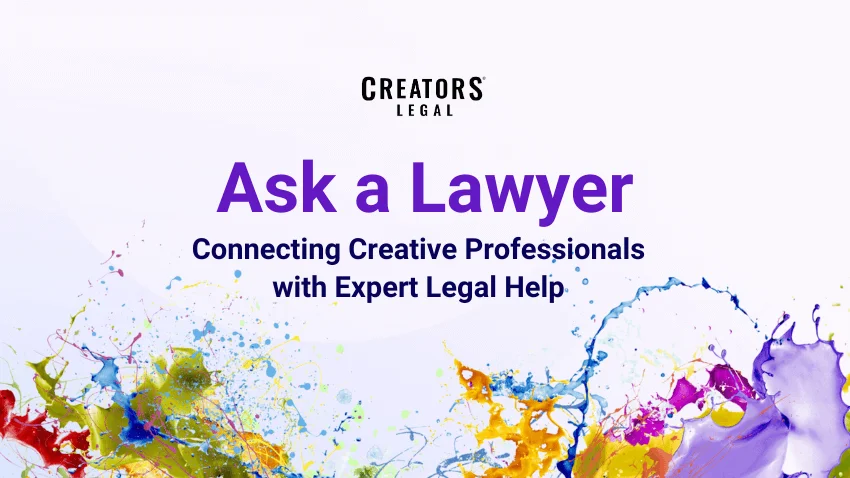Contracts and agreements play a crucial role in the world of visual artists and gallery owners, establishing clear expectations and protecting their interests. Whether you’re an artist looking to showcase your work or a gallery owner seeking to represent talented creators, understanding the legal aspects of the art industry is essential for success.
That’s where Creators Legal comes in – the first and only do-it-yourself platform for creators to get fully legal without the need for expensive lawyers. Our comprehensive guide provides valuable insights and practical tips to help artists and gallery owners navigate the complex world of contracts and agreements.
Key Takeaways:
- Contracts are vital for artists and gallery owners, providing clarity and protection for both parties involved.
- Common types of contracts in the art industry include artist loan agreements, Solo Artist Exhibition agreements, artist consignment agreements, and commission agreements.
- Seeking legal advice on a budget is possible through networking and building relationships with legal professionals and organizations offering pro bono or reduced-cost services.
- Resale royalties can have a significant impact on the art market, and it’s crucial to consult legal counsel before signing any contracts related to resale royalties.
By following the guidance in our guide, artists and gallery owners can build a strong legal foundation, protect their intellectual property, and ensure successful partnerships in the art industry. Don’t let legal complexities hold you back from realizing your artistic vision – let “Creators Legal” guide you to opening night!
Understanding Visual Artists Law
Visual Artists Law encompasses a broad range of legal considerations that artists and gallery owners must be aware of to navigate their creative endeavors successfully. From protecting intellectual property rights to establishing clear terms and expectations, contracts play a crucial role in the art industry. This section will delve deeper into Visual Artists Law and explore its importance in the context of contracts for artists and gallery owners.
One of the key aspects of Visual Artists Law is the protection of intellectual property rights. Artists invest their time, effort, and creativity into their work, and it is essential to safeguard their rights. Contracts help artists retain ownership and control over their artwork, ensuring that they are properly credited and compensated for their creations. Gallery owners also benefit from contracts, as they help establish the terms of exhibiting and selling artwork, protecting both their interests and the artists they represent.
Understanding Visual Artists Law also involves being familiar with the various types of contracts commonly used in the art industry. Grant agreements, for example, are a key mechanism for artists to secure funding and support for their projects. Loan/exhibition agreements outline the terms of borrowing artwork for exhibitions, ensuring proper care and handling. Consignment agreements are vital for artists and gallery owners engaging in art sales, providing a framework for the consignment and sale of artwork. Commission agreements govern the relationship between artists and clients, establishing the scope of work, payment, and delivery terms.
Seeking legal counsel is crucial when it comes to navigating Visual Artists Law and contracts. Artists and gallery owners may have limited budgets, but there are resources available to help, such as “Creators Legal,” a do-it-yourself platform that provides affordable legal solutions for creators. Building relationships and networking within the art community can also lead to connections with legal professionals who offer pro bono or reduced-cost services. By seeking legal advice and understanding the legal landscape, artists and gallery owners can establish a solid legal foundation and safeguard their creative endeavors.
The Role of Contracts in the Art Industry
Contracts serve a vital purpose in the art industry, providing a legal framework for artists and gallery owners to establish clear expectations and protect their interests. These legally binding agreements outline the rights and responsibilities of both parties, ensuring that everyone involved understands the terms of their engagement.
Within the art industry, various types of contracts are commonly used to facilitate different transactions and collaborations. Grant agreements, for example, are essential for artists seeking funding and support for their projects. These agreements outline the terms of the grant, including the scope of work, deliverables, and any reporting requirements.
Loan/exhibition agreements are crucial when artists lend their artwork for display in a gallery or other exhibition spaces. These contracts define the duration of the loan, insurance arrangements, transportation responsibilities, and any conditions for display or promotional activities.
Consignment agreements, another important contract type, are used when artists consign their artwork to galleries or dealers for sale. These agreements specify the terms of the consignment, such as the commission percentage, pricing, duration, and any exclusivity clauses.
Commission agreements are important when artists are creating custom artwork for clients. These contracts outline the scope of the project, including deadlines, specifications, and payment terms. They help ensure both parties are aligned on project expectations and enable artists to protect their intellectual property rights.
By understanding and utilizing these different types of contracts, artists and gallery owners can navigate the art industry more effectively and establish mutually beneficial relationships. Contracts provide a foundation for collaboration, outlining the terms and conditions that both parties must adhere to. They also offer legal protection and can help resolve disputes should they arise.
Navigating Contracts on a Budget
Seeking legal advice doesn’t have to break the bank – artists and gallery owners can explore affordable options to navigate contracts and legal considerations. While hiring a lawyer is always recommended for complex legal matters, there are alternative routes to obtain the necessary guidance without incurring significant expenses.
Networking and building relationships within the art industry can prove invaluable. Connecting with fellow artists, gallery owners, or professionals who have experience with contracts can provide valuable insights and recommendations for affordable legal advice. Joining artist communities, attending art events, and participating in workshops or seminars can help establish connections with legal professionals willing to offer pro bono or reduced-cost services.
There are also organizations dedicated to providing affordable legal assistance to artists and gallery owners. One such platform is Creators Legal, the first and only do-it-yourself platform that enables creators to get fully legal without the need for expensive lawyers. Creators Legal offers accessible resources, templates, and guides tailored specifically to the needs of artists and gallery owners, helping them navigate contracts and protect their interests.
Exploring Alternative Options
For those on a tight budget, it’s crucial to optimize available resources. Conducting thorough research and educating oneself about the legal aspects of the art industry can empower artists and gallery owners to handle certain matters independently. There are numerous books, online courses, and resources available that provide guidance on understanding and drafting contracts.
Additionally, online legal forums and communities can be a valuable source of information and guidance. Engaging in discussions, asking questions, and sharing experiences can help artists and gallery owners gain insight into common legal issues and learn from others’ experiences. However, it’s important to remember that online advice should be taken with caution, and consulting with a professional is always recommended for critical matters.
By exploring these alternative options and leveraging available resources, artists and gallery owners can navigate contracts on a budget while still ensuring legal protection and peace of mind.
Model Consignment Agreement
| Section | Description |
| Parties | Identifies the artist and the gallery owner involved in the consignment agreement. |
| Artwork Details | Specifies the artwork being consigned, including title, medium, dimensions, and any unique identifying information. |
| Terms | Outlines the duration of the consignment, the gallery’s responsibilities, and the artist’s rights and obligations. |
| Pricing and Commission | Establishes the sale price of the artwork and the gallery’s commission or percentage of the sale proceeds. |
| Insurance and Liability | Covers the responsibilities for insuring the artwork and addresses liability for damage or loss. |
| Delivery and Return | Specifies how the artwork is to be delivered to the gallery and the return process in case of unsold artwork or the end of the consignment period. |
| Termination | Outlines the conditions under which the consignment agreement can be terminated by either party. |
| Governing Law | Specifies the jurisdiction and laws that govern the consignment agreement. |
Consignment Agreements for Artists and Gallery Owners
Consignment agreements are a crucial aspect of the art industry, providing a framework for artists and gallery owners to collaborate effectively and protect their interests. These agreements outline the terms and conditions under which an artist’s artwork is entrusted to a gallery for display, promotion, and sale.
“A consignment agreement offers both parties peace of mind,” explains Eric Farber, founder of Creators Legal, the first and only do-it-yourself platform for creators to get fully legal without the need for expensive lawyers. “By clearly defining the responsibilities, obligations, and rights of both the artist and the gallery, it helps prevent misunderstandings and disputes.”
When it comes to drafting a consignment agreement, it’s essential to consider the specific legal requirements of the state in which the agreement will be enforced.
| Key Elements of a Consignment Agreement |
| 1. Identification of the artwork |
| 2. Terms of the consignment |
| 3. Pricing and commission |
| 4. Insurance and liability |
| 5. Promotion and marketing |
It’s important to note that a consignment agreement should be tailored to the specific needs and circumstances of the artist and gallery. While there are model consignment agreements available, it is recommended to consult with a legal professional to ensure that the agreement adequately protects both parties’ interests and complies with relevant laws and regulations.
Resale Royalties and the Art Market
Resale royalties have become a hot topic in the art market, raising legal considerations and prompting artists to seek proper legal guidance before entering into agreements. These royalties, also known as droit de suite, are additional payments made to artists when their artworks are resold on the secondary market.
The concept of resale royalties originated in France in the 1920s and has since been adopted by several countries around the world. The goal is to provide artists with ongoing financial support and recognition for the increasing value of their works. However, the implementation of resale royalty schemes has sparked debates within the art market, with proponents arguing for artists’ rights and opponents expressing concerns about potential negative effects on sales and investment.
When it comes to resale royalties, artists and gallery owners must navigate various legal considerations. Seeking legal counsel is crucial to fully understand the implications of these agreements and ensure that their interests are protected. By consulting with legal professionals who specialize in the art industry, artists and gallery owners can gain insight into specific contract terms, royalty structures, and the impact of resale royalties on future sales.
Understanding the Legal Considerations
Artists and gallery owners should consider the following legal aspects when dealing with resale royalties:
- Contractual agreements: A well-drafted contract is essential to clearly outline the terms and obligations related to the payment of resale royalties. It should specify the percentage or fixed amount of the royalty, the scope of the agreement, and any limitations or exemptions.
- Intellectual property rights: Resale royalty agreements may intersect with artists’ intellectual property rights, such as copyright and moral rights. It is vital to understand how these rights are impacted and how they can be protected within the context of the agreement.
- Enforceability: The enforceability of resale royalty agreements can vary depending on the jurisdiction. Artists and gallery owners should be aware of the specific laws and regulations in their region and seek legal advice to ensure compliance.
By addressing these legal considerations and seeking proper legal counsel, artists and gallery owners can navigate the complexities of resale royalties and protect their interests in the art market.
Building a Strong Legal Foundation for Artists and Gallery Owners
Establishing a strong legal foundation is vital for artists and gallery owners to navigate the complexities of the art industry while protecting their creative works. Contracts play a crucial role in this process, helping to define rights, responsibilities, and expectations for both parties involved. By understanding the importance of contracts and seeking legal counsel when needed, artists and gallery owners can ensure they are safeguarded and supported in their endeavors.
One common type of contract in the art industry is the consignment agreement, which outlines the terms of artwork placement in a gallery and the responsibilities of both the artist and the gallery owner. To assist artists and gallery owners, this guide includes a model consignment agreement that can serve as a starting point for negotiations. It also provides information on consignment statutes in specific states, such as Missouri and Illinois, helping to ensure compliance with local laws.
Seeking legal advice can be costly, but there are ways for artists and gallery owners to access affordable or pro bono legal services. Networking within the art community and building relationships with legal professionals can lead to valuable connections and potential opportunities for reduced-cost legal assistance. Additionally, online platforms like “Creators Legal” provide do-it-yourself resources for creators to get fully legal without the need for expensive lawyers. These options can help artists and gallery owners obtain the legal guidance they need while staying within budget.
Branding and Trademarks for Artists and Gallery Owners
Branding and trademarks are essential elements for artists and gallery owners, allowing them to establish a unique identity and protect their creative works. Through effective branding, artists and gallery owners can build recognition and attract a loyal following. Moreover, trademarks provide legal protection by granting exclusive rights to use a particular name, logo, or design.
When it comes to branding, artists can create a visual identity that represents their artistic style and values. This includes designing a logo, selecting a color palette, and crafting a consistent aesthetic across their artworks, website, and promotional materials. Gallery owners, on the other hand, can enhance their brand by curating collections that align with their mission and showcasing high-quality artworks.
Protecting creative works through trademarks is crucial in the art industry. By registering a trademark, artists and gallery owners can prevent others from using their brand elements without permission. This legal safeguard also enables them to take legal action in case of infringement. Registering a trademark involves filing an application with the United States Patent and Trademark Office (USPTO) and paying the necessary fees. It’s worth noting that seeking legal counsel or using a platform like “Creators Legal” can help simplify the trademark registration process.
Benefits of Trademarks in the Art Industry
Trademark protection offers several advantages to artists and gallery owners. Firstly, it establishes their rights in the marketplace, allowing them to differentiate themselves from competitors. This exclusivity strengthens their brand identity and helps build trust and credibility with collectors, buyers, and the art community. Secondly, trademarks facilitate licensing opportunities, enabling artists and gallery owners to generate additional revenue by granting others the right to use their brand elements in collaborations or merchandise. Lastly, trademarks also enhance the value of artworks and gallery spaces, making them more attractive to potential buyers and investors.
In conclusion, branding and trademarks are invaluable assets for artists and gallery owners looking to establish a strong presence in the art industry. By investing in their brand identity and protecting their creative works, they can safeguard their reputation and attract opportunities for growth and success. Seeking legal advice and utilizing resources like “Creators Legal” can provide valuable guidance and support during the branding and trademark registration process, ensuring a solid legal foundation for artists and gallery owners.
Licensing Agreements in the Art Industry
Licensing agreements offer artists and gallery owners the opportunity to monetize their artwork while ensuring their intellectual property rights are properly protected. These agreements establish a legally binding relationship between the creator of the artwork, known as the licensor, and the party seeking to use or reproduce the artwork, known as the licensee.
Within the art industry, licensing agreements are commonly used when artists want to reproduce their artwork on merchandise such as prints, t-shirts, or home decor items. Gallery owners may also enter into licensing agreements to reproduce artwork for promotional materials or exclusive partnerships with other businesses.
When entering into a licensing agreement, it is crucial for artists and gallery owners to clearly define the rights and responsibilities of both parties. This includes specifying the scope of the license, the duration of the agreement, any limitations or restrictions on use, and the compensation or royalties to be paid to the licensor.
Key Considerations for Licensing Agreements
When negotiating and drafting a licensing agreement, artists and gallery owners should consider the following:
- Scope of License: Clearly define how the artwork can be used, whether it’s for reproduction, distribution, or adaptation.
- Duration: Determine the length of time the licensing agreement will be in effect, including any renewal or termination clauses.
- Compensation: Establish the financial terms of the agreement, such as upfront fees, royalties, or a percentage of sales.
- Quality Control: Include provisions that allow the licensor to review and approve any products or materials featuring the licensed artwork to ensure consistency and protect the artist’s reputation.
- Intellectual Property Rights: Specify that the licensor retains all ownership and copyright of the artwork, and outline the licensee’s obligations to protect the artist’s intellectual property.
By carefully considering these factors and seeking legal counsel if needed, artists and gallery owners can enter into licensing agreements that not only generate income but also safeguard their creative work.
A well-drafted contract can also help artists and gallery owners by defining the scope of their liability, setting limits on potential damages, and outlining the steps to be taken in case of any product-related disputes. Furthermore, contracts can provide a platform for artists and galleries to establish return and refund policies, which can help manage customer expectations and minimize the risk of legal disputes.
By carefully considering and addressing product liability in contracts, artists and gallery owners can protect themselves, their customers, and their businesses. Consulting with legal professionals and utilizing resources such as “Creators Legal” can provide valuable guidance and ensure that contracts are comprehensive and legally sound.
Returns and Refunds Policies in the Art Industry
Clear and comprehensive returns and refunds policies are crucial for artists and gallery owners, allowing them to establish fair terms and maintain positive relationships with their customers. In the art industry, where customers may have varying tastes and preferences, having a well-defined policy can help avoid misunderstandings and disputes.
When creating returns and refunds policies, artists and gallery owners should consider factors such as the nature of the artwork, shipping and handling processes, and the potential impact on their business. Here are some key considerations:
- Clearly define the timeframe for returns and refunds. This not only helps manage customer expectations, but also ensures that artists and gallery owners can assess the condition of returned artworks in a timely manner.
- Specify the conditions for accepting returns, such as the state of the artwork and any packaging requirements. Artists and gallery owners may consider including a restocking fee for returned items that are not in their original condition.
- Address the issue of refunds, whether in the form of store credit, partial refunds, or full reimbursement. Providing options can be beneficial for both parties and help maintain customer satisfaction.
Table 1: Returns and Refunds Policy Example
| Returns and Refunds Policy | Conditions | Refund Options |
| Within 30 days of purchase | Artwork must be in its original condition | Full refund or store credit |
| After 30 days of purchase | Artwork must be in its original condition with a 20% restocking fee | Store credit or partial refund |
By clearly communicating their returns and refunds policies to customers, artists and gallery owners can build trust and credibility. Additionally, it is essential to document these policies in contracts with buyers to ensure mutual understanding and prevent any potential conflicts.
“Having a well-defined returns and refunds policy not only protects the interests of artists and gallery owners, but also provides peace of mind for customers. It builds confidence in the buying process and encourages repeat business,”
While returns and refunds policies are essential, it is equally important for artists and gallery owners to monitor and evaluate the effectiveness of their policies over time. Regularly reviewing and updating these policies based on customer feedback and industry trends can help create a seamless and satisfactory buying experience for all parties involved.
Seeking Legal Counsel for Artists and Gallery Owners
While navigating contracts and legal considerations, artists and gallery owners should prioritize seeking professional legal counsel to ensure their interests are protected and their creative endeavors flourish. The art industry is complex, and understanding the legal aspects can be overwhelming. That’s where Creators Legal comes in.
Creators Legal is the first and only do-it-yourself platform for creators to get fully legal without the need for expensive lawyers. Our mission is to make legal knowledge accessible and affordable for artists and gallery owners. With our user-friendly platform, you can create, customize, and sign legally binding contracts tailored to your specific needs.
By utilizing Creators Legal, you gain access to a wide range of contract templates, including grant agreements, loan/exhibition agreements, consignment agreements, and commission agreements. These templates provide a solid foundation for your business relationships, protecting your rights as an artist or gallery owner.
We understand that not everyone can afford expensive lawyers, especially in the early stages of their artistic careers. That’s why we encourage networking and building relationships within the art industry. By connecting with legal professionals and organizations that offer pro bono or reduced-cost services, you can find the affordable legal counsel you need to navigate the complexities of contracts and ensure your best interests are represented.
Creators Legal empowers artists and gallery owners to take control of their legal needs. With our comprehensive platform, you can protect your work, establish clear expectations, and foster successful collaborations. Don’t let legal considerations hold you back. Sign up for Creators Legal today and embark on a journey towards a solid legal foundation for your creative endeavors.
Conclusion
Understanding Visual Artists Law and having well-structured contracts are vital for artists and gallery owners to navigate the complexities of the art industry and protect their interests. Contracts and agreements play a crucial role in establishing clear expectations, outlining rights and responsibilities, and safeguarding intellectual property.
In this comprehensive guide, we have explored various types of contracts that are commonly used in the art world. From grant agreements to loan/exhibition agreements, consignment agreements to commission agreements, each contract serves a specific purpose in ensuring a smooth and fair relationship between artists and gallery owners.
We have also provided practical tips for artists and gallery owners who may be operating on a budget but still need legal advice. Networking and building relationships with legal professionals and organizations that offer pro bono or reduced-cost legal services can be a valuable resource in seeking affordable legal guidance.
To assist artists and gallery owners further, we have included a model consignment agreement in this guide. Additionally, we have touched upon the importance of consignment statutes, particularly in Missouri and Illinois, that provide legal protection and guidelines for consignment transactions.
Lastly, we have discussed the concept of resale royalties and the significance of seeking legal counsel before engaging in any contracts related to this area. Resale royalties can have a profound impact on the art market, and it is crucial to understand the advantages and challenges before entering into such agreements.
A consignment agreement is a contract between an artist and a gallery owner in which the gallery agrees to display and sell the artist’s work on a consignment basis. It is important because it establishes the terms of the consignment, including pricing, commission, and responsibilities of both parties.
What is the significance of resale royalties in the art market?
Resale royalties are an important aspect of the art market as they provide ongoing income to artists when their works are resold. They can help support artists financially and recognize their contributions to the value of their works over time.
How can artists and gallery owners build a strong legal foundation?
Artists and gallery owners can build a strong legal foundation by utilizing contracts to protect their rights and intellectual property, seeking legal counsel when needed, and staying informed about the legal aspects of the art industry.
Empower your creative journey with the right legal tools. Explore Creators Legal for tailored solutions and guidance tailored just for you.
Read More:
Five Things to Consider When Drafting a Contract for Your Creative Business
The Ultimate Proof of Ownership for Every Artist and Creator






